 |
|

|
 |
TABLE of CONTENTS
|
Hwy 55's 'Connected Corridor' to help advance CAV technology |
By Sue Roe
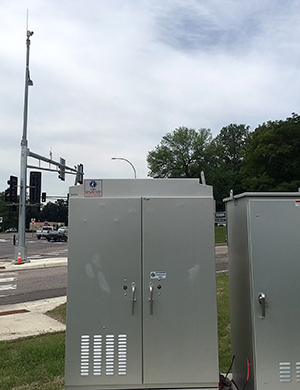
The technology of the connected corridor includes a transmitter cabinet located at each intersection and an antenna located near the traffic signal. The antenna transmits the signal change to the transmitter box, which sends the information to vehicles that have receivers. Photo by Kevin Chan |
As car companies continue to design connected and automated technology for their vehicles, MnDOT is developing the communications infrastructure and data management systems to support those existing and future technologies.
This infrastructure will enable the exchange of information between vehicles and equipment at intersections.
This Vehicle-to-Infrastructure, or V2I technology, will allow for several applications to be deployed that improve safety and efficiency of roadway users.
Initially, the V2I technology will be installed and used on the Hwy 55 corridor between downtown Minneapolis and Interstate 494 beginning in September.
Cory Johnson, Connected Corridors program manager, said the technology will capture and broadcast signal information, such as when a light is turning green or red, to vehicles directly from traffic signal controllers along the corridor.
“Right now, motorists have limited ability to determine when a signal will change so they can slow their vehicle’s speed to stop at the light or to adjust their speed to pass through the intersection on green,” Johnson said. “With the infrastructure providing real-time traffic signal data, motorists can better anticipate signal phase changes. Stopping and accelerating at traffic signals results in wasted fuel and that’s one benefit of V2I technology.”
Information, such as a signal change, is transmitted wirelessly, via a transmitter box installed near an intersection, to anyone who has a receiver to listen.
Johnson says not many vehicles have that kind of receiver now, but it’s coming.
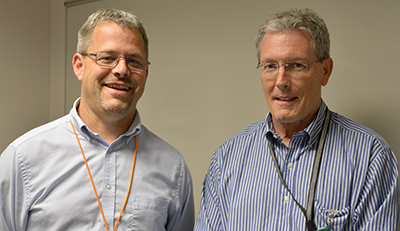
Cory Johnson, left, manages the Connected Corridor program, which is part of MnDOT’s new Connected and Automated Vehicle office, and Dan Rowe is the project manager. Photo by Sue Roe |
“Toyota will have that capability in all their cars by 2020,” he said.
Other car makers are working to have the technology in their cars too. The National Highway Traffic Safety Administration is currently in the process of requiring all new cars, pickups and SUVs sold in the U.S. to be equipped with dedicated short-range communications. This will enable drivers to receive basic information about location, speed and critical operations of a vehicle.
The signal timing application is part of the Signal, Phase and Timing, or SPaT technology. SPaT technology is the backbone of the Connected Corridor project and it will enable MnDOT to deploy a range of applications, including:
- Snowplow signal priority – This will be tested this winter on one snowplow along Hwy 55 during night-time hours. The snowplow driver will get “prioritized treatment” at traffic signals for plow clearing operations. Requesting priority is enabled through the broadcast of a message from the snowplow. This will reduce the number of stops and allow the operator to clear intersections in a single pass, reducing total snow clearance time and getting the plow off the road faster. It will also reduce the uneven application of chemicals.
- Vehicle-Pedestrian intersection conflict warning – This will alert bus drivers when a pedestrian is in a signalized intersection that a bus may travel through. A section of I-494 in St. Louis Park will also be used to test this system.
Partnerships with the private sector are also on the horizon to offer real-time traffic signal data to motorists, Johnson said. By sharing this SPaT data with these third-party traveler information providers, consumers will use eco-driving applications through systems in vehicles or on mobile devices.
The Connected Corridor will have 22 intersections installed with V2I technology. The first five SPaT signals will be operational by Nov. 5. The other signals will go online by December. The pedestrian conflict warnings, snowplow signal priority and third-party access will go online in summer 2019.
Saving fuel, reducing driver stress and improving roadway safety are the main benefits of this far-reaching technology.
Johnson said MnDOT’s work with connected and automated technology is also helping MnDOT gain experience and knowledge of new technologies to prepare for the future of transportation.
“A big part of this right now is teaching MnDOT people,” he said. “We’re learning internally as much as we can as fast as we can. We’re building a foundation to support and advance connected and automated vehicles on the roadways.”
Read about MnDOT’s other intelligent transportation projects. |
 |
|

|
 |
TABLE of CONTENTS
 |
MnDOT showcases innovation, environmentally friendly transportation solutions at 2018 State Fair booth |
By Mary McFarland Brooks

The Polaris Gem 2 electric and automated vehicle will be part of the MnDOT state fair booth Aug. 27. It is part of the innovation series at the booth. Photo courtesy of Polaris |
The 2018 MnDOT State Fair booth, in the Education Building, will feature information on Corridors of Commerce, the agency’s equity and diversity efforts, how to engage with the agency, along with ways MnDOT is applying innovative, cost-effective and environmentally friendly solutions to transportation issues.
“MnDOT prides itself in planning, building and maintaining a safe, accessible and reliable transportation network that connects people and businesses to destinations and markets throughout the world,” said Commissioner Charlie Zelle. “The Minnesota State Fair lets us showcase what we do for the people we serve to make for a better Minnesota. We hope fairgoers stop by to chat and see some of the latest innovations we’re exploring.”
MnDOT employees will be available to talk about specific ways that the agency uses innovation and technological solutions to solve transportation issues on the days listed below:
- Monday, Aug. 27 (9 a.m. to 9 p.m.) – Connected and Automated Vehicles. This technology has the potential to reduce crashes by minimizing human factors during driving. Minnesota is monitoring and testing how CAV works in winter weather conditions.
- Tuesday, Aug. 28 (10 a.m. to 2 p.m.) – Hydraulics Inspection Vehicle Explorer. This remote-controlled vehicle, created by MnDOT staff using off-the-shelf hobby shop parts, helps crews inspect pipes and culverts. It’s already helped the state reduce costs and save time, and was recognized with a Governor’s Better Government Award for Great Results.
- Wednesday, Aug. 29 (10 a.m. to 2 p.m.) – Drones. MnDOT has been testing unmanned aerial systems for several years and uses them in mapping, surveying and inspecting the state’s many bridges.
- Thursday, Aug. 30 (10 a.m. to 2 p.m.) – Northern Lights Express. Come see the corridor model of the proposed, higher speed passenger rail project that would provide rail service between Minneapolis and Duluth.
- Friday, Aug. 31 (10 a.m. to 2 p.m.) – Living snow fences. Learn about MnDOT’s partnership with farmers to create living snow fences (e.g., rows of trees, shrubs, native grasses and wildflowers located along roads or around communities and farmsteads) that help trap snow before it reaches a road. This helps improve driver visibility and reduces maintenance costs and plow time.
Fairgoers can also get their photo taken against a green screen and superimposed in a “transportation setting” at the MnDOT booth.
Agency staff will also be present in other locations at the state fair:
- Aug. 23-Sept. 3 – Eco Experience –MnDOT staff participates in the Kick Gas, Tilting to Transit, Vanpooling and Safety Town exhibits emphasizing transit, traffic safety and safe routes to school along with distributing state bike maps.
- Aug. 23-Sept. 3 -- Experimental Aircraft Association’s Spirit of Aviation exhibit located on the NE corner of Judson Ave. and Nelson St., is a STEM based interactive display with hands-on activities, virtual technology and flight simulators.
- Aug. 23 (8 a.m. to 5 p.m.) – MnDOT staff will be participating in STEM Day in Dan Patch Park near the Grandstand. Bring children K-12 to engage in science, technology, engineering and math activities, including trying out a snowplow simulator.
- Aug. 27 and 29 (2 p.m.) – See the MnDOT snowplow and Minnesota GoMobile in the daily parade down Cosgrove Street.
Employees are encouraged to volunteer annually at the State Fair for an opportunity to hear from our customers’ first-hand about their concerns and also their ideas to improve Minnesota’s transportation system. |
 |
|

|
 |
TABLE of CONTENTS
 |
Concrete replacement, reduced conflict intersection highlight Hwy 169 project near Jordan |
|
By Kirsten Klein, Metro District public affairs coordinator
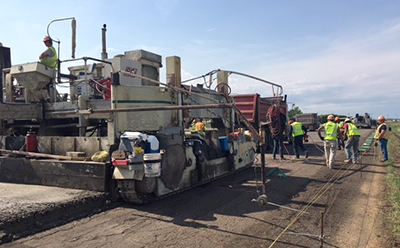
Crews replace concrete pavement on Hwy 169 near Belle Plaine. Photo by Tracy Buck |
Hwy 169 has several construction projects going on along the highway across Minnesota. Construction on the section of the highway between Jordan and Hwy 19 began April 30.
The road project is repairing and replacing the concrete pavement on Hwy 169 from south of Hwy 282 in Jordan to just north of Hwy 19. The project will also construct a reduced conflict intersection at Hwy 59 and Delaware Avenue in Jordan.
“It originally was a two year project that we were able to condense into one construction season by building the crossovers last fall,” said Curt Kallio, Metro District construction engineer.
Once all the roadwork is completed, a cable median barrier will be installed along Hwy 169 between Hwy 19 and Hwy 282.
“The project is running about 3 weeks behind due to weather and a few other delays, but should still make their overall completion date, said Kallio.
The project is scheduled to be completed in October. More information about the $33.3 million project can be found on the Hwy 169 project website. |
 |
|

|
 |
TABLE of CONTENTS
 |
Seema Desai accepts position of Office of Equity and Diversity director |
By Rich Kemp

Seema Desai is the director of Office of Equity and Diversity. Photo by Judy jacobs |
Seema Desai has accepted the position as director of the Office of Equity and Diversity. In this role, Desai oversees the agency-wide equity, diversity and inclusion, equal opportunity, non-discrimination and affirmative action activates and programs. She is responsible for providing advice and legal consultation to ensure compliance with all applicable state and federal laws relating to employment discrimination.
Desai joined MnDOT in 2015 as the discrimination case manager, where she managed internal and external discrimination matters related to MnDOT’s workforce. Over the past year, she has served as acting director of the office.
She has a juris doctor degree from Hamline University School of Law and a bachelor of science in gender, women, sexuality studies and Asian American studies. Desai is a licensed attorney and a qualified mediator, with over ten years of experience in the field of Civil Rights, including enforcement of municipal, state, and federal discrimination laws.
“Seema is particularly well suited for this role.” said Eric Davis, chief of staff. “She not only has the strong legal and technical background we depend on this office to provide, but perhaps more importantly she demonstrates the genuine, personal leadership qualities needed for our collective diversity and inclusion efforts to thrive.” |
 |
|

|
 |
TABLE of CONTENTS
 |
COOP exercise helps MnDOT get ready |
|
By Rich Kemp
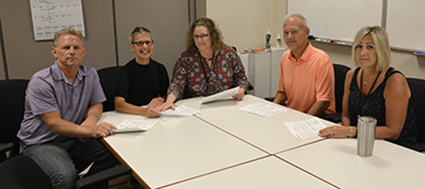
The first COOP exercise was with the Office of Administration (from left) Charlie Giddings, CO purchasing supervisor; Carol Magurany-Brotski, CO COOP coordinator; Suzi Thayer, office director; Craig Gardner, operations manager; and Renee Gaspar, accounts payable supervisor. Photo by Rich Kemp |
The Office of Emergency Management has conducted Continuity of Operation Planning exercises to make sure that MnDOT offices can operate during an interruption. The plan is to continue doing business as usual, even during interruptions.
"COOP exercising is really interesting and can be a fun part of continuity of operation planning," said Carol Magurany-Brotski, CO COOP coordinator. "Employee participation and feedback provides the most valuable information to see how things function outside their primary work area."
Governor’s Executive Order 15-14 requires all state agencies to be prepared and able to maintain continuity of essential government services should they experience an interruption (short or long term) caused by a loss of facility, loss of technology, loss of personnel or loss of services due to a variety of technological, natural or human-made exposures.
To maintain MnDOT’s capabilities, the COOP training, testing and exercise program involves different levels to assess response and provide information to keep MnDOT personnel appraised of roles, responsibilities and general COOP activation information. Major components of this program include training personnel in their COOP responsibilities; conducting periodic exercises to test and improve COOP plans and procedures, systems and equipment. It ensures that MnDOT’s COOP and employees are capable of supporting the continued execution of its state essential functions/priority services throughout the duration of an emergency.
Recently COOP functional exercises were conducted in Central Office to assess priority services performance when they were out of the primary service location. The CO services that participated in the exercises include the Office of Administration’s Account Payable and Purchasing, Office of Financial Management’s Payroll Unit, Safeguarding MnDOT and Human Resources. MN.IT @DOT was also instrumental in the COOP planning exercises.
“It’s a real eye opener of how many things you don’t think about until you conduct an exercise like this,” said Charlie Giddings, CO purchasing supervisor. “It will definitely prepare our office In the event that something would happen”
The exercises involved employees being able to perform their services at an alternate site location or emergency teleworking. The exercise included many preparation meetings, site testing, communications, training and the exercise itself.
“There is no pass/fail grade in a COOP exercise,” said Magurany-Brotski. “It is a learning experience on what worked or did not work so adjustments can be made going forward. COOP support and participation has been very positive by employees and senior leadership.”
Additional exercises are being planned for this fall. More information on COOP can be found on the Office of Emergency Management website.
|
 |
|

|
|

|
 |
TABLE of CONTENTS
 |
Districts use county fairs, community events to engage, inform, recruit |
By Armoni Jackson, Public Engagement and Constituent Services Office

Employees in District 4 drove a snowplow June 15 in the Perham Turtle Fest Parade. Photo courtesy of District 4 |
During the summer of 2018, MnDOT was present at more than 20 community events around the state. These events included county fairs, parades, carnivals and the Safe Summer Nights annual community gathering, along with events like National Afternoon Out, Stand Down Veteran event and peace celebrations.
Community engagement and providing information about job opportunities at MnDOT was a common goal for all districts. District 1 participated in the Duluth area Sportsman’s Show, the Home Show at the Duluth Entertainment and Convention Center and at quarterly coffee and conversation meetings in Virginia. District 2 and District 4 used the snow plow as a way of showcasing the equipment used to keep Minnesota roads up to standard at the Perham Turtle Fest Parade. Job information was provided along with small giveaways like highway maps, ice scrapers and sunglasses.
“Snow plows are great addition to community parades,” said Emma Olson, District 4 public affairs coordinator.
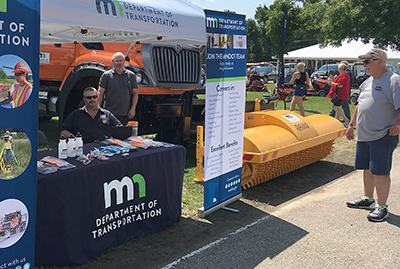
Employees from the Austin truck station staffed a booth at the Mower County Fair in August. Photo courtesy of District 6 |
Anne Meyer, District 6 public affairs coordinator, reported that the district’s Austin truck station has staffed a booth at the Mower County Fair the past two years.
“Participating in the fair started through a WIG initiative as a way to help recruit snow plow operators,” said Meyer. “This year, truck station staff had a MnDOT ice breaker and the Minnesota Go Mobile on site to showcase equipment and entertain the kids. Several hundred fairgoers stopped to visit us over the five day event.”
In the metro area, the Rethinking I-94 Project team used incentives, including job information and a drawing for backpacks, to further engage and inform their communities about the ending of the Phase 1 project study which spans I-94 between Minneapolis and St. Paul.
“Phase 1 of Rethinking I-94 — conducted between January 2016 and August 2018 — focused on understanding the I-94 corridor and the communities along the interstate,” said Mallysa Cartier, I-94 team member. “Moving into Phase 2, the project team will use this public input to develop and evaluate transportation improvement actions for I-94.” |
 |
|

|
|

|
 |
TABLE of CONTENTS
 |
Agency receives two State Government Innovation Awards |
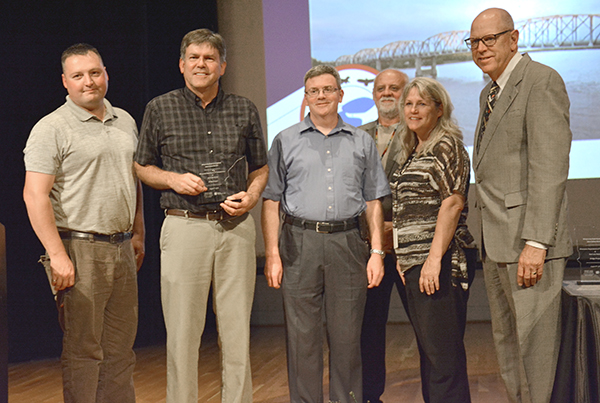
MnDOT received two awards during the State Government Innovation Awards ceremony Aug. 9 in St. Paul. (top, from left) Jeremy Hadrava and Jim Curran, District 2; Jim Cownie, Chief Counsel Office; and Ed Fairbanks and Cindy Bellefeuille, MnDOTís tribal relations team; received an innovation award from Jay Kiedrowski, Humphrey School of Public Affairs, for their partnership with the Red Lake Nation during a project on Hwy 1 that traveled though the reservation. (bottom, from left) Jim Skoog, Brenda Rivera, Laurel Janisch and Richard Davis, Office of Public Engagement and Constituent Services; received an innovation award from Kiedrowski for new programs that help connect customerís inquiries to specific roadway segments.Photos by Rich Kemp
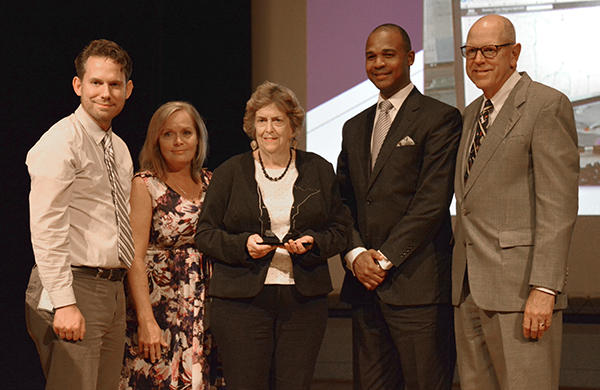
|
|
 |
|

|
 |
TABLE of CONTENTS
 |
Meet Justin, District 6 maintenance worker |
This video is part of a series of MnDOT maintenance worker video profiles. Justin Key is a maintenance worker at the Red Wing truck station in District 6. Video produced by Rich Kemp |
|
 |
|
| |
|



